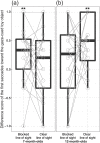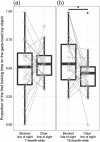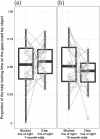Visual perspective-taking ability in 7- and 12-month-old infants - PubMed (original) (raw)
Visual perspective-taking ability in 7- and 12-month-old infants
Ayaka Ikeda et al. PLoS One. 2022.
Abstract
Understanding how we see the world is different from how other people see it is a crucial part of social cognition and is known as visual perspective-taking. Although previous studies have demonstrated that 14-month-old infants have the capacity to compute the visual perspectives of others, it remains unknown whether infants under 12 months also have this ability. In this study, we modified a conventional gaze-following experimental setting in which one toy was placed in front of a model and was hidden by a barrier (Blocked Line of Sight Condition), and another toy was placed without a barrier (Clear Line of Sight Condition). We examined the visual perspective-taking abilities of 48 infants aged 7 and 12 months by measuring the infants' gaze shift towards the gaze-cued toy object with and without a barrier. The results demonstrated that 12-month-old infants could correctly follow a model's gaze if the model's line of sight was clear. In contrast, 7-month-old infants showed no evidence of such capacity. Our findings indicate that 12-month-old infants seem to have the capacity to compute the visual perspective of others.
Conflict of interest statement
The authors have declared that no competing interests exist.
Figures
Fig 1. Schematic of study events.
(a) Introduction Phase (10 s): The female model moved to the left and then to the right twice behind the barrier. This served to make infants aware that it occluded the model. (b) Familiarization Phase (5 s): Two identical toy objects were displayed with a barrier. One of the toy objects was placed in front of the barrier, and the other was not. (c) Test Phase (20 s in total): The model stared straight ahead for 4 s accompanied by a voice saying, “Ah, Omocha-ga Aruyo! (Ah, here is a toy!).” Then, the model gazed at either the toy object that was occluded by the barrier, (Blocked Line of Sight Condition) or the toy object that was not occluded by the barrier (Clear Line of Sight Condition). The order of the Blocked Line of Sight and Clear Line of Sight Conditions was counterbalanced. Note: An eye-catcher scene was displayed before the Introduction Phase and Familiarization Phase. It was also displayed before both the Blocked Line of Sight and Clear Line of Sight Conditions in the Test Phase, respectively. This was done to direct the infants’ visual attention toward the screen.
Fig 2. Difference score of the first saccades toward the gaze-cued toy object for the Blocked Line of Sight and Clear Line of Sight Conditions.
Results are shown for the (a) 7-month-old infants and (b) 12-month-old infants. The central mark indicates the median, and the bottom and top edges of the box indicate the 25th and 75th percentiles, respectively. The upper whisker (vertical line) extends from the third quartile to the largest value. However, this is no further than 1.5 interquartile ranges from the third quartile. The lower whisker extends from the 25th percentile down to the smallest value. This goes no further than 1.5 interquartile ranges from the first quartile. **p < 0.01.
Fig 3. Proportion of the first looking time on the gaze-cued toy object for the Blocked Line of Sight and Clear Line of Sight Conditions.
Results are shown for the (a) 7-month-old infants and (b) 12-month-old infants. The central mark indicates the median, and the bottom and top edges of the box indicate the 25th and 75th percentiles, respectively. The upper whisker (vertical line) extends from the third quartile to the largest value. However, this was no further than the 1.5 interquartile ranges from the third quartile. The lower whisker extends from the 25th percentile down to the smallest value. However, this was no further than 1.5 interquartile ranges from the first quartile. * p < 0.05.
Fig 4. Proportion of the total looking time on the gaze-cued toy object for the Blocked Line of Sight and Clear Line of Sight Conditions.
Results are shown for the (a) 7-month-old infants and (b) 12-month-old infants. The central mark indicates the median. The bottom and top edges of the box indicate the 25th and 75th percentiles, respectively. The upper whisker (vertical line) extends from the third quartile to the largest value. However, this was no further than 1.5 interquartile ranges from the third quartile. The lower whisker extends from the 25th percentile down to the smallest value. However, this was no further than 1.5 interquartile ranges from the first quartile.
Similar articles
- To see or not to see: infants prefer to follow the gaze of a reliable looker.
Chow V, Poulin-Dubois D, Lewis J. Chow V, et al. Dev Sci. 2008 Sep;11(5):761-70. doi: 10.1111/j.1467-7687.2008.00726.x. Dev Sci. 2008. PMID: 18801132 - 12- and 18-month-old infants follow gaze to spaces behind barriers.
Moll H, Tomasello M. Moll H, et al. Dev Sci. 2004 Feb;7(1):F1-9. doi: 10.1111/j.1467-7687.2004.00315.x. Dev Sci. 2004. PMID: 15323111 - Automated gaze-contingent objects elicit orientation following in 8-month-old infants.
Deligianni F, Senju A, Gergely G, Csibra G. Deligianni F, et al. Dev Psychol. 2011 Nov;47(6):1499-503. doi: 10.1037/a0025659. Epub 2011 Sep 26. Dev Psychol. 2011. PMID: 21942669 Free PMC article. - The developmental origins of naïve psychology in infancy.
Poulin-Dubois D, Brooker I, Chow V. Poulin-Dubois D, et al. Adv Child Dev Behav. 2009;37:55-104. doi: 10.1016/s0065-2407(09)03702-1. Adv Child Dev Behav. 2009. PMID: 19673160 Review. - Taking an action perspective on infant's object representations.
Gredebäck G, von Hofsten C. Gredebäck G, et al. Prog Brain Res. 2007;164:265-82. doi: 10.1016/S0079-6123(07)64015-1. Prog Brain Res. 2007. PMID: 17920437 Review.
References
- Piaget J, Inhelder B. The child’s conception of space. London: Routledge & Kegan Paul; 1956.
- Lempers JD, Flavell ER, Flavell JH. The development in very young children of tacit knowledge concerning visual perception. Genet Psychol Monogr. 1977;95(1):3–53. Epub 1977/02/01. . - PubMed
Publication types
MeSH terms
Grants and funding
M.H.: Japan Society for the Promotion of Science (JSPS) KAKENHI Grant Numbers 15H05310 and 15KK0129 Japan https://www.jsps.go.jp/english/e-grants/index.html The funders had no role in study design, data collection and analysis, decision to publish, or preparation of the manuscript.
LinkOut - more resources
Full Text Sources
Medical



